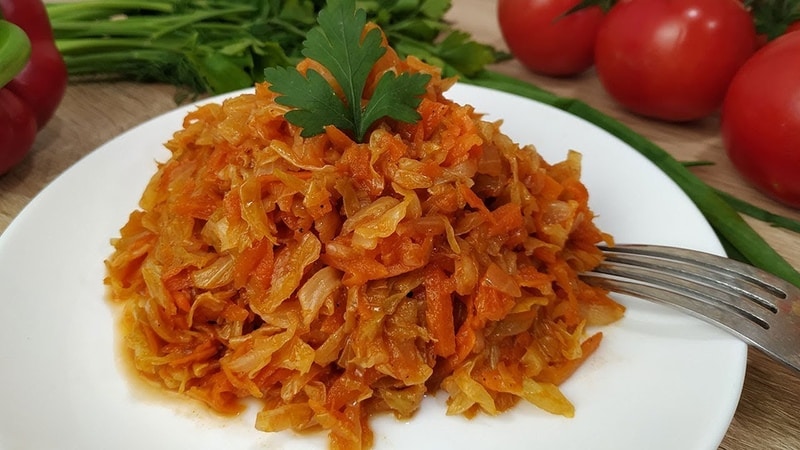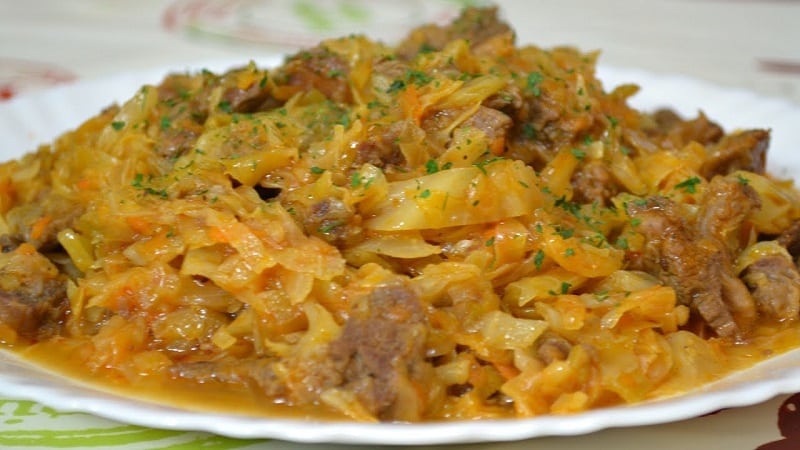Is it possible to eat stewed cabbage while breastfeeding and will it harm the baby?
Stewed cabbage during breastfeeding improves lactation in a nursing woman, normalizes the process of digestion and assimilation of food. For a child, leafy vegetables are a source of B vitamins, ascorbic acid and retinol. Minerals in plant foods pass into breast milk, are easily absorbed in the baby’s body, and are used to strengthen the bone structure and develop the baby’s skeletal muscles.
Is it possible to eat stewed cabbage while breastfeeding?

Braised cabbage not prohibited for use while breastfeeding. This herbal product does not contain highly allergenic substances or compounds harmful to children such as nitrates, preservatives, or synthetic components. When consumed correctly, the leafy vegetable saturates mother's milk with vitamins and minerals: using it in the diet is not only possible, but also recommended.
Stewed cabbage does not harm the baby’s body in 99% of cases. Nutrients from leafy vegetables, which the newborn absorbs through breast milk, improve metabolism and normalize acid-base and water-electrolyte balance.
Composition, properties, contraindications

Cooked leafy vegetables contain the following nutritional compounds:
- tanning components;
- ash;
- coarse and soluble plant fiber;
- micro- and macroelements: potassium, calcium, magnesium, iron, cobalt, chromium, manganese;
- vitamins: retinol, ascorbic acid, B1, B2, B5, B6.
During heat treatment, the coarse fibers in cabbage soften, making it easier to digest and absorb by the mother's body. Up to 30% of organic acids and vitamins are destroyed, but the product does not lose its basic beneficial properties:
- improves digestion;
- stabilizes kidney function, promotes the removal of excess fluid;
- relieves swelling of soft tissues;
- enhances peristalsis of intestinal smooth muscles;
- reduces serum cholesterol and triglyceride levels;
- cleanses the intestines of toxins;
- normalizes metabolism.
There are the following contraindications to the mother consuming stewed cabbage:
- increased acidity of gastric juice;
- intestinal spasms;
- enterocolitis;
- exacerbation of peptic ulcer;
- kidney diseases.
It is recommended that women with high blood pressure avoid eating this dish, especially if the cabbage leaves are over-salted. The minerals they contain, together with sodium chloride, cause fluid retention. As a result, swelling occurs and blood pressure increases.
Benefits and harms for the mother

It is recommended to introduce boiled cabbage into the diet. If there is no negative reaction in the baby, the product can be consumed stewed as a separate dish.
The leafy vegetable brings many benefits to the woman’s body:
- stimulates the production of breast milk, saturates it with vitamins and mineral compounds;
- suppresses the growth of pathogenic microorganisms;
- has a general strengthening effect, increases the functional activity of the immune system;
- relieves constipation, improves intestinal motility;
- B vitamins prevent the development of sclerosis and improve cognitive function;
- increases performance, gives vigor;
- promotes the removal of slag masses, toxic compounds and excess liquid;
- reduces serum levels of bad cholesterol;
- increases the elasticity of blood vessels, improves hematopoiesis;
- Vitamin A protects the retina from the negative effects of ultraviolet radiation;
- Regular use of cabbage prevents the development of breast cancer and prevents the formation of blood clots;
- Antioxidants in the product improve the condition of nails, strengthen hair, and restore the elasticity and firmness of the skin.
Stewed cabbage causes harm due to diseases of the digestive tract. These include ulcers, enterocolitis, gastritis of hyperacid and hypacid forms in the acute stage. When a leafy vegetable enters a woman’s stomach, it stimulates the production of hydrochloric acid and active enzymes, and therefore can aggravate the pathological process.
Abuse of herbal products leads to the following effects:
- increased gas formation in the intestines;
- bloating, feeling of heaviness in the epigastric area;
- increased risk of developing gastritis, heartburn;
- constipation, flatulence;
- In rare cases, an allergic reaction to the product is possible.
For a child
The benefit of stewed cabbage for babies is that the vitamins and mineral components it contains pass into breast milk. It is saturated with nutrients necessary for the normal growth and development of the baby.
B vitamins normalize the child’s psycho-emotional state and improve cognitive functions. stimulate thinking processes. Minerals strengthen the musculoskeletal system, bone structure and cartilage tissue. Retinol improves the functioning of the visual analyzer.
Harm from stewed cabbage is rarely observed. It appears when a child has an individual intolerance to the product or when the mother of a baby abuses leafy vegetables.
In such situations, the following side effects are observed:
- in children under 4 months of age, intestinal colic occurs;
- constipation;
- flatulence;
- gas formation increases;
- swelling is observed;
- skin rash, itching, soft tissue swelling and hyperemia.
Rules for use during lactation

To avoid negative effects, a nursing woman is advised to adhere to the following rules when consuming stewed cabbage:
- For the first test, prepare broccoli or cauliflower. Only after them can the white cabbage variety be stewed. For the first time, use no more than 50-70 g of the product, then observe the child’s reaction for 1.5-2 days. During this period, the development of food allergies in a newborn is possible. If the reaction is positive, the introduction of cabbage into the diet is postponed for 30 days.
- If the baby is not allergic to stewed cabbage, a woman can consume the leafy vegetable 150-200 g per day 2-3 times a week.
- After 2-3 months after birth, you can add salt, sugar, black pepper, bay leaf, onions and herbs to the cabbage. Sour cream, olive or sunflower oil are suitable as a dressing.
- For cooking, choose fresh heads of cabbage with tight, dense leaves. Before stewing, they are thoroughly washed.
Important! It is strictly forbidden to eat foods with rotten or withered leaves.
How and when to introduce it into the diet
Stewed cauliflower and broccoli can be consumed 2-3 weeks after birth. It is recommended that a nursing woman include the Beijing variety in her diet at 1-2 months of a child’s life.It is advisable to consume white cabbage 3-4 months after giving birth. A similar rule applies to kelp and sauerkraut, which are planned to be stewed.
It is not recommended to add large amounts of vegetable oil and spices when preparing the leafy vegetable. It is necessary to simmer the product until completely softened. A small amount of salt and ground black pepper is allowed.
What time of day and how much is there?

It is advisable to consume stewed cabbage in the morning, when the body's tone is increased and the metabolic rate is high. During this period, the child’s gastrointestinal tract absorbs new nutrients more easily. The risk of intestinal colic is reduced.
In the evening, metabolism slows down and the tone of the digestive organs decreases. As a result, the risk of developing negative effects in the infant increases:
- bowel disorder: constipation or diarrhea;
- skin rashes;
- excitability of the nervous system is observed, which causes insomnia, sleep quality deteriorates, and the child becomes capricious;
- sharp pain in the epigastric region.
The recommended amount of stewed cabbage per day, regardless of the variety, is 150-200 g per day.
What to combine with
Stewed cabbage goes well with the following foods:
- chicken breast;
- rice;
- buckwheat;
- turkey meat;
- bell pepper;
- lean beef, rabbit;
- white roots;
- carrots, onion.
You can stew different types of cabbage with other vegetables.
Is it possible to give it to a child?
Stewed white cabbage can be given to a breastfed baby at the age of 1 year, preferably after zucchini. Broccoli, cauliflower - at 8-10 months.By this time, his digestive tract will be ready to digest coarse fiber, intestinal colic will finally stop bothering the baby, so the plant product will not harm the child.
Formula-fed babies are allowed to try the dish at the age of 8 months. Before serving, the cabbage is pureed.
Attention! It is strictly forbidden to stew cabbage for babies with butter, salt and spices.
What kind of stewed cabbage can you use?

White cabbage It is characterized by a high content of ascorbic and folic acid. Vitamin C and B9 are essential for the normal functioning of the immune and nervous systems. The only disadvantage of this variety is that it is difficult to digest even when stewed. This is due to the content of a large amount of coarse plant fiber. Therefore, it is not introduced into the diet of a child under 1 year of age. If the baby often suffers from colic, the mother is advised not to eat cabbage until 3-4 months after birth.
Broccoli and cauliflower have a high content of vitamin A and group B. Ascorbic acid in their composition supports the functional activity of lymphocytes. Leafy vegetables are considered hypoallergenic and, compared to the cabbage variety, easily digestible. Due to their porous structure, they can be consumed by a woman 2-3 weeks after giving birth.
Broccoli improves peristalsis of intestinal smooth muscles, cauliflower cleanses of waste materials and toxins. Both products are taken as a prevention of gastritis and cancer. Vitamins and minerals increase stress resistance and accelerate the recovery of the female body after the birth of a child.
Sea kale refers to algae.Due to the high content of mineral salts, it is not recommended for use in infancy. When stewed, they become concentrated, so kelp often causes an allergic reaction. The product is usually included in the menu of a nursing mother no earlier than 4-5 months after birth in small quantities. Laminaria is useful for replenishing iodine reserves in the body. It strengthens blood vessels, improves heart function and prevents blood clots.
Stewed sauerkraut It is not recommended for consumption, as it relates to marinades and pickles. It contains a large amount of vinegar, organic acids and spices. They disrupt the digestion process, worsen the taste of breast milk and lead to dehydration of the woman’s body. Lactation decreases, milk becomes thick. This product is allowed to be consumed by mothers in limited quantities, no more than 50 g per day, when the child is 6-7 months old.
Reference! If sauerkraut is included in the diet, it is necessary to increase the amount of drinking water in the diet. This will help avoid problems with lactation.
Stewed cabbage recipes for nursing mothers

To prepare a classic recipe for stewed cabbage with other vegetables, you will need the following ingredients:
- 600 g white cabbage;
- 3 tomatoes;
- 2 medium sized carrots;
- 375 ml water;
- a bunch of greenery;
- 40 ml vegetable oil;
- 2 bay leaves;
- onion head;
- salt and ground black pepper to taste.
The head of cabbage is cleaned of outer leaves, the stalk is removed, and cut into pieces. The onion is chopped, the carrots are grated, then fried in a heated frying pan with the addition of vegetable oil for 2-3 minutes.After this time, add the cabbage and fry the chopped tomatoes for another 3 minutes.
Next, add water to the ingredients and simmer for 20-25 minutes until the cabbage leaves soften. 5 minutes before cooking add bay leaf, salt and pepper. If desired, add 1 tbsp. l. sour cream. Sprinkle the dish with chopped herbs before serving.
If it is difficult to get enough vegetables, a nursing woman can prepare stewed cabbage with rice according to the following recipe:
- 600 g white cabbage;
- 150 g rice;
- 3 tomatoes;
- 375 ml water;
- 2 carrots;
- onion;
- 40 ml vegetable oil.
Fry chopped onion and grated carrots in hot oil for 3 minutes. Finely chop the cabbage, add to the vegetables, and fry together. The tomatoes are blanched, peeled, chopped and added to other vegetables. Next, the dish is salted and peppered. The rice is thoroughly washed, mixed with other ingredients and filled with water. Simmer until the rice softens.
To diversify your diet and improve lactation, you can prepare cabbage with meat and prunes:
- 300 g chicken fillet;
- 7 prunes;
- 2 carrots;
- 500 g white cabbage;
- 300 ml water;
- onion;
- 40 ml vegetable oil;
- 1 tsp. granulated sugar;
- salt and pepper as desired.
The onion is chopped, the carrots are grated. The chicken fillet is washed, dried and cut into cubes. Finely chop the cabbage. Pour oil into the pan and heat it over medium heat, then add the poultry meat and fry for 10 minutes. Onions and carrots are added to the chicken. Cook them for 5 minutes. Next, put cabbage in a saucepan, cover with sugar, pour in water and simmer for an hour under a closed lid. The prunes are washed and cut into large cubes, after which they are added to the dish along with pepper and salt.
Conclusion
Stewed cabbage benefits the body of mother and child, so women are allowed to consume it during breastfeeding. The product stimulates lactation, saturates with vitamins and mineral components. It is advisable to introduce the leafy vegetable at least 2-3 weeks after delivery. Babies should not be given cabbage until they are 12 months old. For bottle-fed babies, you can try giving a pureed product after 8 months.